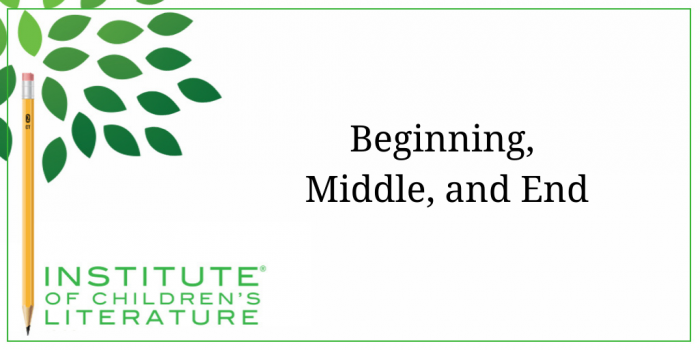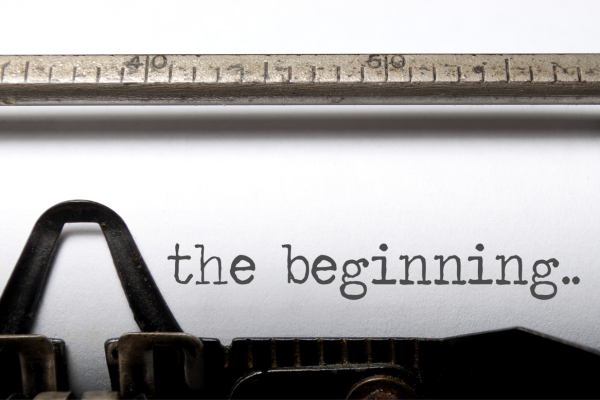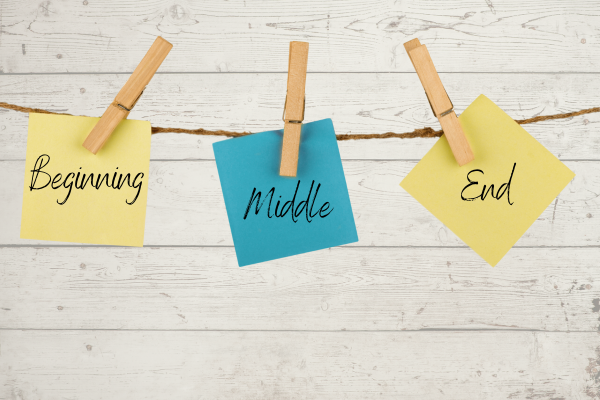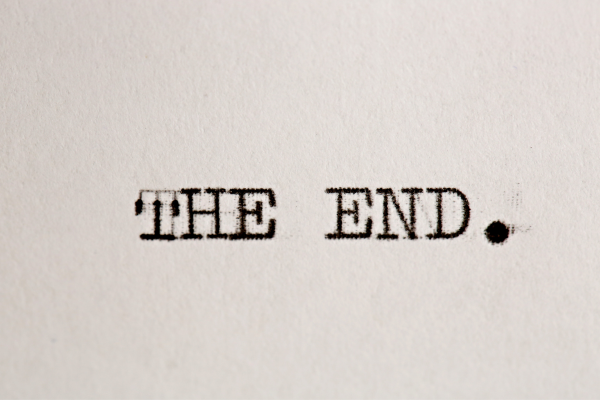1000 N. West Street #1200, Wilmington, DE 19801
© 2024 Direct Learning Systems, Inc. All rights reserved.

Although the structure of both fiction and nonfiction can be broken down and described in different ways, one simple method is simply to think of your book, story, or article as having a beginning, middle, and end. Though these parts are fairly equal in importance, they are not equal in length. The beginning and ending are shorter than the middle. And each serves the reader in different ways.
 In the beginning…
In the beginning…Every piece of writing has a beginning and that beginning must entice a reader away from all the other things that clamber for his attention. It must engage the reader fully to hold that attention, and must launch the story or article you’re offering. A beginning is a kind of promise to the reader. It creates expectations. If those expectations are not met, the reader will lose interest. Therefore the promise you make the reader needs to be true.
These days, most of us are familiar with clickbait, the showy, drama-implying titles written to lure someone to click on a link. A clickbait title makes a big promise, but once the person clicks the link, the promise is rarely fulfilled. It’s the modern version of a carnival barker promising you wonders beyond belief if you hand over your money and slip into the darkened tent. But too often, those wonders turn out to be flimflam that fool only the most gullible. This may grab readers on the Internet, but it will not net sales for a writer sending manuscripts to publishers. What your story or article opening promises, it must deliver.
One thing your story or article opening must never be is confusing. You can pique interest and draw the reader in, hungering for more, but you cannot confuse. Confusion doesn’t lead to engagement. Instead, a confused reader is often a reader who walks away from your story. Therefore your opening needs to be completely clear.
The first thing to consider with clarity is foreknowledge. You should not assume a ton of foreknowledge from a young reader unless you are writing about a subject you absolutely know they’ve come into contact with before. So your opening shouldn’t be heavy with jargon (including scientific jargon). If you’re writing fantasy, your opening shouldn’t be heavy with made-up words. It shouldn’t open on a scene that demands a ton of story foreknowledge to follow. Keep the writing direct, clear, and lively.
 In the beginning…
In the beginning…In fiction, an opening that is heavy with information (even information you feel the reader needs) will kill interest. This information dumping is called exposition and you want as little of it as possible. If you’re certain the opening won’t make sense unless you stop and tell the reader a bunch of stuff, then you’re starting the story in the wrong place. Instead of dumping exposition on the reader, open with the character moving. In life, movement draws the eye and in reading, movement engages the brain in much the same way. But the movement needs to be purposeful. It should show us this character and get the story going. For example, perhaps your story opens with a girl sitting dully on a chair before a mirror, brushing her hair and counting. She does this every day and it’s representative of how dull her life is and how unhappy she is about it. She wishes something, anything would happen. And that’s when someone rushes into the room to tell her something has arrived (a dragon? a suitor? an army?) that will quickly make the girl long for the good old days of boredom, while pushing her into a life-changing growth experience. I could have simply opened with an info dump of thoughts from the girl, but putting her in a moment with action makes the beginning more immediate and engaging.
In nonfiction, the opening often does something similar by offering the reader one of the most interesting, exciting, or unexpected things about the topic. Suppose you’re writing about a tiny sea creature that turns itself inside out after every meal as a way of eliminating wastes. The idea of a creature that can turn itself inside out and survive could be interesting and engaging for a young reader. (I don’t actually know if such a creature exists, but wouldn’t it be cool?) Opening with something cool grabs the reader with promise (if this is cool, imagine what I might tell you next!), with clarity, and with action. (Keep in mind that I wouldn’t use impressive zoology words in the opening. I’d paint the picture of the little creature flipping itself inside out as though it were a sock.)
The middle of any book, story, or article is all about fulfilling the promises made in the opening. In fiction, the middle begins as the main character begins making choices and pursuing actions to resolve the problems he or she faces. As the character acts, the situation changes (not always for the better) and this succession of action/change, action/change is what makes up the middle of the book.

In nonfiction, the middle is where the information begins to unfold following the structure you planned for the piece. There are many possible structures in nonfiction and the one you choose will be the one that best matches the topic and the information you plan to give. For instance, with narrative nonfiction (such as a biography) the structure is usually chronological. You tell the events as they happened. But suppose I’m writing something like “Global Warming: How Did We Get Here?” In that case, I may do a combination of cause-effect and chronological, because I would show things that happened and the effects of those things, but I’d probably do them mostly in chronological order.
Whether fiction or nonfiction, the middle of your piece is the longest part, by far. Most of the word count of your novel, your nonfiction book, your story, or your article is spent in fulfilling the promise of your beginning.
So what’s left at the end? Can’t you just pop in a “they all lived happily ever after” and be done? Actually endings are really important to readers. They are not only when the major problem is resolved and we see the characters finally get a moment to rest. They are also the point where you can be certain all the puzzles are solved and loose ends tied up. Readers really dislike a book that leaves a lot of unanswered questions.

In nonfiction, especially nonfiction articles, it can really be tempting to simply skip writing an end. After all, you’ve shared all the information and you feel done. But if you don’t have a solid ending to a nonfiction article, you can leave the reader unsatisfied. You’ve taken the reader’s time. Sure, you gave them fascinating facts, but are you leaving them feeling abruptly dumped? Do they end up feeling as if they know the point of the article they’ve read?
For nonfiction, the ending can be a good time to conclude the piece with the big idea that ties it all together. It also offers you a chance to close with something clever. Readers love the feeling of “punch line” that a clever ending sentence can offer.
So in the most basic of structures: beginning, middle, and end, each part serves a purpose. The middle may be the biggest section, but it isn’t the most important in terms of reader engagement. That award goes to the beginning. The beginning might be the spot where you capture the reader, but if you don’t send them off feeling satisfied, they won’t remember your piece fondly. That means the ending is essential as well. Beginning, middle, and end are vital to your writing success, so be sure you learn to love all three.
With over 100 books in publication, Jan Fields writes both chapter books for children and mystery novels for adults. She’s also known for a variety of experiences teaching writing, from one session SCBWI events to lengthier Highlights Foundation workshops to these blog posts for the Institute of Children’s Literature. As a former ICL instructor, Jan enjoys equipping writers for success in whatever way she can.
1000 N. West Street #1200, Wilmington, DE 19801
© 2024 Direct Learning Systems, Inc. All rights reserved.
1000 N. West Street #1200, Wilmington, DE 19801
© 2024 Direct Learning Systems, Inc. All rights reserved.
1000 N. West Street #1200, Wilmington, DE 19801
© 2024 Direct Learning Systems, Inc. All rights reserved.
1000 N. West Street #1200, Wilmington, DE 19801
© 2024 Direct Learning Systems, Inc. All rights reserved.

1000 N. West Street #1200, Wilmington, DE 19801
© 2025 Direct Learning Systems, Inc. All rights reserved.

1000 N. West Street #1200, Wilmington, DE 19801
©2025 Direct Learning Systems, Inc. All rights reserved. Privacy Policy.
6 Comments